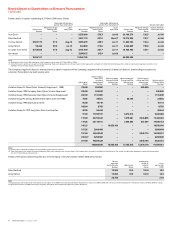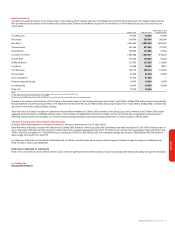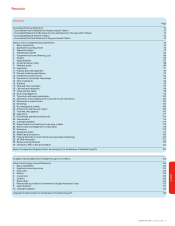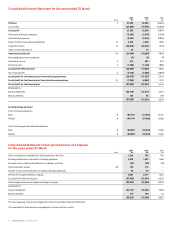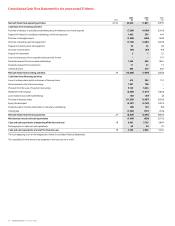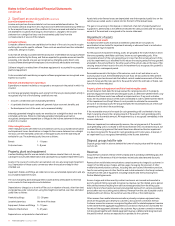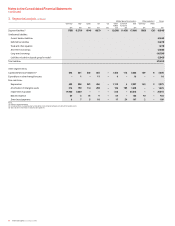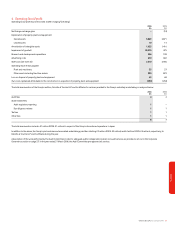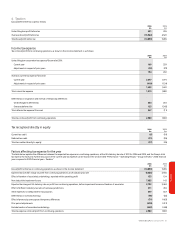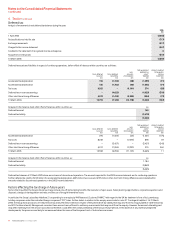Vodafone 2006 Annual Report Download - page 79
Download and view the complete annual report
Please find page 79 of the 2006 Vodafone annual report below. You can navigate through the pages in the report by either clicking on the pages listed below, or by using the keyword search tool below to find specific information within the annual report.
Vodafone Group Plc Annual Report 2006 77
Revenue from data services and information provision is recognised when the Group has
performed the related service and, depending on the nature of the service, is recognised
either at the gross amount billed to the customer or the amount receivable by the
Group as commission for facilitating the service.
Incentives are provided to customers in various forms and are usually offered on signing
a new contract or as part of a promotional offering.
Where one-off incentives are provided on connection of a new customer or the upgrade
of an existing customer, revenue representing the fair value of the incentive, relative to
other deliverables provided to the customer as part of the same arrangement, is
deferred and recognised in line with the Group’s performance of its obligations relating
to the incentive.
For equipment sales made to intermediaries, revenue is recognised if the significant risks
associated with the equipment are transferred to the intermediary and the intermediary
has no general right of return. If the significant risks are not transferred, revenue
recognition is deferred until sale of the handset to an end customer by the intermediary
or the expiry of the right of return.
Intermediaries are incentivised by the Group to connect new customers and upgrade
existing customers. Where such incentives are separable from the initial sale of
equipment to an intermediary, the incentive is accounted for as an expense upon
connection, or upgrade, of the customer.
Revenue from other businesses primarily comprises amounts charged to customers of
the Group’s fixed line businesses, mainly in respect of access charges and line usage,
invoiced and recorded as part of a periodic billing cycle.
Inventory
Inventory is stated at the lower of cost and net realisable value. Cost is determined on
the basis of weighted average costs and comprises direct materials and, where
applicable, direct labour costs and those overheads that have been incurred in bringing
the inventories to their present location and condition.
Leasing
Leases are classified as finance leases whenever the terms of the lease transfer
substantially all the risks and rewards of ownership of the asset to the lessee. All other
leases are classified as operating leases.
Assets held under finance leases are recognised as assets of the Group at their fair value
at the inception of the lease or, if lower, at the present value of the minimum lease
payments as determined at the inception of the lease. The corresponding liability to the
lessor is included in the balance sheet as a finance lease obligation. Lease payments are
apportioned between finance charges and reduction of the lease obligation so as to
achieve a constant rate of interest on the remaining balance of the liability. Finance
charges are recognised in the income statement.
Rentals payable under operating leases are charged to the income statement on a
straight line basis over the term of the relevant lease. Benefits received and receivable as
an incentive to enter into an operating lease are also spread on a straight line basis over
the lease term.
Foreign currencies
In preparing the financial statements of the individual entities, transactions in currencies
other than the entity’s functional currency are recorded at the rates of exchange
prevailing on the dates of the transactions. At each balance sheet date, monetary items
denominated in foreign currencies are retranslated at the rates prevailing on the balance
sheet date. Non-monetary items carried at fair value that are denominated in foreign
currencies are retranslated at the rate prevailing on the date when fair value was
determined. Non-monetary items that are measured in terms of historical cost in a
foreign currency are not retranslated.
Exchange differences arising on the settlement of monetary items, and on the
retranslation of monetary items, are included in the income statement for the period.
Exchange differences arising on the retranslation of non-monetary items carried at fair
value are included in the income statement for the period except for differences arising
on the retranslation of non-monetary items in respect of which gains and losses are
recognised directly in equity. For such non-monetary items, any exchange component
of that gain or loss is also recognised directly in equity.
For the purpose of presenting Consolidated Financial Statements, the assets and
liabilities of entities with a functional currency other than sterling are expressed in
sterling using exchange rates prevailing on the balance sheet date. Income and expense
items and cash flows are translated at the average exchange rates for the period and
exchange differences arising are recognised directly in equity. Such translation
differences are recognised in the income statement in the period in which a foreign
operation is disposed of.
Goodwill and fair value adjustments arising on the acquisition of a foreign operation are
treated as assets and liabilities of the foreign operation and translated accordingly.
In respect of all foreign operations, any exchange differences that have arisen before
1 April 2004, the date of transition to IFRS, are deemed to be nil and will be excluded
from the determination of any subsequent profit or loss on disposal.
Borrowing costs
All borrowing costs are recognised in the income statement in the period in which they
are incurred.
Post employment benefits
For defined benefit retirement plans, the difference between the fair value of the plan
assets and the present value of the plan liabilities is recognised as an asset or liability on
the balance sheet. The Group has early adopted the amendment to IAS 19, “Employee
Benefits”, issued by the IASB on 16 December 2004 and applied it from 1 April 2004.
Accordingly, actuarial gains and losses are taken to the statement of recognised income
and expense. For this purpose, actuarial gains and losses comprise both the effects of
changes in actuarial assumptions and experience adjustments arising because of
differences between the previous actuarial assumptions and what has actually occurred.
Other movements in the net surplus or deficit are recognised in the income statement,
including the current service cost, any past service cost and the effect of any
curtailment or settlements. The interest cost less the expected return on assets is also
charged to the income statement. The amount charged to the income statement in
respect of these plans is included within operating costs or in the Group's share of the
results of equity accounted operations as appropriate.
The values attributed to plan liabilities are assessed in accordance with the advice of
independent qualified actuaries.
The Group's contributions to defined contribution pension plans are charged to the
income statement as they fall due.
Cumulative actuarial gains and losses as at 1 April 2004, the date of transition to IFRS,
have been recognised in the balance sheet.
Taxation
Income tax expense represents the sum of the current tax payable and deferred tax.
Current tax payable or recoverable is based on taxable profit for the year. Taxable profit
differs from profit as reported in the income statement because some items of income or
expense are taxable or deductible in different years or may never be taxable or deductible.
The Group’s liability for current tax is calculated using UK and foreign tax rates and laws
that have been enacted or substantively enacted by the balance sheet date.
Deferred tax is the tax expected to be payable or recoverable in the future arising from
temporary differences between the carrying amounts of assets and liabilities in the
financial statements and the corresponding tax bases used in the computation of
taxable profit. It is accounted for using the balance sheet liability method. Deferred tax
liabilities are generally recognised for all taxable temporary differences and deferred tax
assets are recognised to the extent that it is probable that taxable profits will be available
against which deductible temporary differences can be utilised. Such assets and
liabilities are not recognised if the temporary difference arises from goodwill or from the
initial recognition (other than in a business combination) of assets and liabilities in a
transaction that affects neither the taxable profit nor the accounting profit.
Deferred tax liabilities are recognised for taxable temporary differences arising on
investments in subsidiaries and associates, and interests in joint ventures, except where
the Group is able to control the reversal of the temporary difference and it is probable
that the temporary difference will not reverse in the foreseeable future.
The carrying amount of deferred tax assets is reviewed at each balance sheet date and
reduced to the extent that it is no longer probable that sufficient taxable profits will be
available to allow all or part of the asset to be recovered.
Deferred tax is calculated at the tax rates that are expected to apply in the period when
the liability is settled or the asset realised, based on tax rates that have been enacted or
substantively enacted by the balance sheet date.
Tax assets and liabilities are offset when there is a legally enforceable right to set off
current tax assets against current tax liabilities and when they either relate to income taxes
Financials



